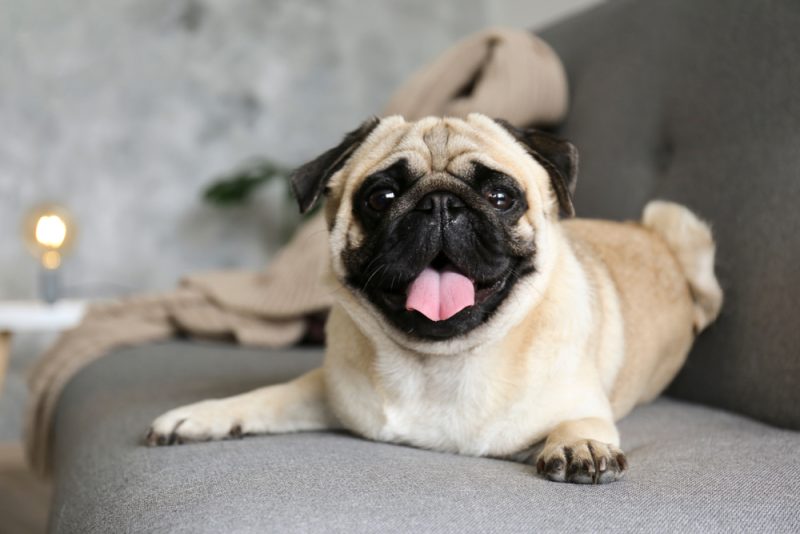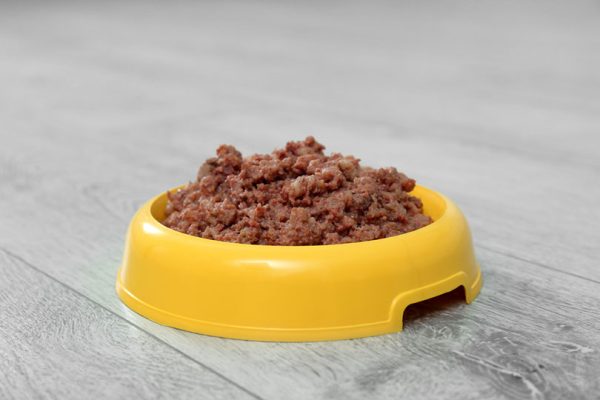In this article
View 8 More +The Dachshund Rottweiler mix is a unique dog indeed. This mixed breed is often referred to as the Dachsweiler. Sadly, it is difficult to predict much at all about this breed because they can vary considerably.
You may end up with a dog that is as massive as a Rottweiler or one that is much closer to a Dachshund in size. Typically, this breed falls somewhere in the middle. They are often solidly built like a Rottweiler but with the extremely short legs of a Dachshund.
Breed Overview
Height:
12 – 24 inches
Weight:
30 – 100 pounds
Lifespan:
8 – 12 years
Colors:
Bi-color
Suitable for:
Active families with previous dog-owning experience
Temperament:
Protective, active, confident
That said, they do typically have a bi-colored pattern. Of course, it does depend on the coloration of the Dachshund parent. In some cases, these puppies can have different colors.
As far as temperament goes, you can expect these intelligent dogs to be a bit protective. They are extremely loyal to their families, but they can be a bit noisy.
Keep reading to learn about these interesting canines.
Rottweiler Dachshund Mix Characteristics

Dachshund Rottweiler Puppies
The Rottweiler Dachshund Mix is extremely difficult to find. In many cases, you’ll need to seek out a qualified, informed breeder. Due to the size difference between the parent dogs, this mixed breed is often more difficult to breed. Therefore, breeders are few and far between.
There often isn’t much demand for Dachshund Rottweiler puppies, so there is little reason for breeders to begin producing these puppies. This does keep the price lower, however.
While mixed breeds are often prevalent at shelters and rescues, this particular breed is generally not. It is difficult for Rottweilers and Dachshunds to breed, though not impossible. Breeders typically use artificial insemination because a male Dachshund is often too small to mate with a female Rottweiler. In a natural setting, this sort of mating usually doesn’t happen.
Therefore, accidental litters are not common. Most of these dogs are the result of intentional breeding, usually at the hands of a breeder.


Temperament & Intelligence of the Rottweiler Dachshund 🧠
The temperament of the Rottweiler Dachshund is usually a bit on the aloof, protective side. The Rottweiler was specifically bred for guarding purposes, and the Dachshund isn’t typically the friendliest dog with strangers.
At the same time, the Rottweiler Dachshund is great at hunting. They have a strong prey drive and are good at tracking down scents. Sometimes, they can even follow a trail that is over a week old!
Their hunting abilities do depend on the traits that they inherit and their early life experiences. We generally don’t recommend this breed as a hunting dog, but you should be aware that they will carry those instincts.
Generally, these dogs are loyal to their people. They aren’t the most affectionate dogs out there, but they will bond heavily with their families. That said, their high-energy nature makes them best for active families, as they do need regular exercise.
In many cases, this mixed breed would rather play than cuddle.
The intelligence of this breed can vary somewhat. However, in many cases, they have an average intelligence for a working dog. They can learn many necessary commands and a few others. However, that doesn’t necessarily mean that they are the easiest dog to train.
Due to their Dachshund parent, these dogs can be a bit stubborn. It isn’t that they don’t understand what you want. It’s that they believe that their instincts and interpretation of the situation are better than yours.
Therefore, we recommend training classes starting at a young age, especially due to their often-protective nature.
Are These Dogs Good for Families? 🏡
Yes, these dogs can be good for families. They are often larger than the Dachshund, which makes them a better choice for smaller children. They’re less likely to be accidentally injured due to their solidly built physique, which also lowers the chance that they’ll become fearful of children.
That said, their longer back does cause difficulties. If a child pushes on their back or jumps on them, they can develop serious spinal issues. For this reason, they are best only for well-behaved children.
You should also be careful to supervise all interactions between these dogs and children.
We recommend these dogs for more active families. While they aren’t always as active as some other breeds, they do require a significant amount of exercise. In some cases, it can be difficult for less active families to meet these needs.
Does This Breed Get Along with Other Pets? 🐶 😽
They can get along with other dogs when socialized correctly. They need to be taken around other dogs starting at a young age. Otherwise, they may see other dogs as threats and treat them accordingly.
You need to make meeting new dogs a common occurrence. Then, there will be no reason for your Dachweiler to become protective.
Puppy classes are highly recommended. These group classes get your puppy around other dogs at a young age, enabling them to build social skills.
Due to their high prey drive, we do not recommend these dogs for homes with cats or other small animals. They will chase them, and there is often little that you can do to train out that instinct.

Things to Know When Owning a Dachshund Rottweiler Mix
Food & Diet Requirements 🦴
For the most part, these dogs don’t have any special dietary requirements. However, you should speak with your vet about whether your specific dog may benefit from a large breed of food. Feeding these dogs appropriately as puppies is extremely important. Otherwise, they may be more prone to health conditions later in life. If your particular dog appears to be on the bigger side, you may need to invest in large-breed dog food.
All dogs are prone to problems with obesity. However, this breed is particularly prone to issues when overweight due to their long back. Bodyweight is a predisposition factor to intervertebral disc disease and a wide variety of other conditions.
Therefore, you should keep an especially close eye on your dog’s body weight and be prepared to speak to your vet if you notice any issues.
Exercise 🐕
These dogs are quite active. Both their parent breeds require a bit of exercise, so you should plan on this mixed breed requiring the same. We don’t recommend them for inactive families that may have trouble meeting their high exercise requirements.
Daily walks are necessary, along with regular playtime. You should consider implementing games that can wear the dog out without requiring you to expel much energy, like fetch.
A fenced-in backyard can be great for this breed. But you cannot simply leave them in a backyard and expect all their exercise needs to be met independently. Unless encouraged to get up and move, this breed will often lie around more than necessary.
Due to their long back, they should avoid exercise that involves jumping. Jumping and similar movements can seriously injure their back. They cannot do canine sports like agility, which often require significant amounts of jumping.
Training 🦮
Due to their protective instincts, these dogs need quite a bit of training and socialization. Otherwise, they can think that everything is a threat. Most dogs and people they will meet are not threats, but these dogs can’t know that without proper socialization.
Therefore, we recommend getting these dogs in group classes. For puppies, this can often be done as early as their first round of shots. Most training places won’t allow dogs to go to classes unless they have at least these vaccinations, anyway.
For older dogs, we highly recommend attempting group classes, as these provide socialization and training. However, if your dog is too reactive, you may need to choose individual classes for now and upgrade to group classes later.
While these dogs do need plenty of training, the ease at which they can be trained varies significantly. Sometimes, they are quick to pick up on commands and devoted enough to follow them when it matters. Other times, they can be much more stubborn and may not listen to commands when you need them to.
Dachshunds are particularly quite bad at listening to commands. They sometimes pass this trait onto their mixed-breed puppies.
Grooming ✂️
In most cases, these dogs do not require significant amounts of grooming. They will have short fur, which is relatively low-maintenance. However, they will shed quite a bit, so regular brushing is required. Once a week is typically enough for most dogs. But these canines have regular “shedding seasons.” During these periods, you may want to brush them as often as every day to remove the bulk of their excess fur.
These brushing sessions will also help keep your canine clean. The brush will remove dirt and debris along with the excess fur. If you keep up with regular brushing sessions, you shouldn’t have to bathe your canine nearly as often.
Health and Conditions ❤️
For the most part, these dogs are quite healthy. As a mixed breed, they are not nearly as prone to health conditions as some other dogs.
However, these dogs are still prone to a few certain issues. Most prevalent is intervertebral disc disease, which occurs due to their elongated back. While they are a mixed breed, they will likely have a longer back. For this reason, you can expect that they will be prone to this disease, just like Dachshunds.
Generally, this condition occurs when the dog’s elongated back is injured. However, the injury can be extremely minor. For instance, a jump can shock a dog’s back and cause this condition. Treatment is often hit-or-miss. Sometimes, crate rest is useful, while medication may be required at other times. In extreme cases, surgery may be needed.
Bloat can also occur, especially if the dog is on the bigger side. This condition occurs for unknown reasons. However, it can get very serious very quickly. In many cases, the dog will die without fast vet care.
Hip dysplasia and patellar luxation can also occur. However, these happen at lower instances in this breed than they do others. These dogs aren’t particularly prone to these conditions, but they can still occur with some frequency.
Luckily, proper breeding can go a long way toward preventing these conditions from occurring.
- Hip dysplasia
- Patellar luxation
- Intervertebral disc disease
- Bloat

Male vs. Female
There is not a significant difference between the males and females of this breed. You will find both males and females that are large, for instance. Genetics seems to have the biggest role in this breed’s disposition and appearance, not their sex.
That said, males and females have basic hormonal differences that can affect their overall personalities.
For example, studies have found that male dogs are more likely to bite than female dogs. Of course, the exact reasons behind this are unknown, but it could be affected by the male’s hormonal differences. Males are also more likely to wander off, especially if they smell a female.
On the other hand, females are more likely to experience regular hormonal changes. When they go into heat, females can become more affectionate. However, they may also wander off during this time. Generally speaking, females tend to go through more hormonal changes than males, which can directly affect their personalities.

3 Little-Known Facts About the Rottweiler Dachshund Mix
1. They often look like Rottweilers with short legs.
Dachshunds have a dwarfism gene that affects their legs. This gene is the reason that they are shaped the way that they are. Usually, this gene is passed onto the mix, which gives them shorter legs too! In some cases, these dogs look exactly like Rottweilers but with short legs like a Dachshund.
2. This mixed breed varies substantially.
The Dachweiler can vary from dog to dog. Even puppies in the same litter can be incredibly different. Therefore, we don’t recommend this breed for those that want a certain type of dog. After all, you just don’t know what you’ll be getting!
3. The Rottweiler Dachshund is usually protective.
Both the Rottweiler and Dachshund can be a bit protective of their people and territory. Therefore, you can usually expect these dogs to be considerably protective too. Plenty of socialization is recommended for this reason.

Conclusion
The Dachshund Rottweiler mix is an odd combination that generally only occurs due to professional breeders. These dogs are not great at breeding together on their own, so artificial insemination or some other method is often necessary.
Therefore, this breed is fairly rare. They are often described as Rottweilers with short legs, though they can vary quite a bit depending on what genetics they inherit. Since they are a mixed breed, you never know exactly what kind of puppy they are going to grow up into.
Usually, this breed will be quite active. Therefore, we only recommend them for similarly active families. They are not a good option for families that just want a dog to lie around and cuddle with. These dogs should receive at least an hour or two of moderate physical activity a day.
When socialized and trained properly, this breed can make a wonderful addition to the correct family.
We have lots more Rottweiler Mixes and Dachshund Mixes for you to explore!
Related reads:



















